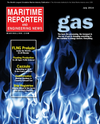
Page 27: of Maritime Reporter Magazine (July 2014)
Offshore Energy Structures & Systems
Read this page in Pdf, Flash or Html5 edition of July 2014 Maritime Reporter Magazine
www.marinelink.com 27 sel engines have been discussed widely during the last several years. To what extent shipping companies have now adjusted is not easily known. However it is clear that no matter which techni- cal solution is chosen, ship operation in the SECA’s will be signifi cantly more expensive.
The Norwegian cruise and transport shipping company Color Line together with Wärtsilä recently introduced its fl eet retrofi t program with scrubbers to reduce the sulfur emissions.
As the Color Line’s vessels operates solely on the Baltic Sea, they focused on three alternatives before they ordered scrubbers from Wärtsilä: • Conversion of the engine operation from heavy fuel to gas oil, which may be the simpliest but, because of the signifi - cantly higher fuel price, is an expensive solution. • Conversion of the engine operation from heavy fuel to natural gas: This is an available technical solution and gas sup- ply in Norway is plentiful, but it is ahigh investment costs to convert the engines and the infrastructure on board. • Continue engine operation with in-
Desulfurization
Left
The fi rst ferry to be retrofi tted is the Color Line Super Speed 2, which will be carried out in
April this year.
Right
IMO and EU sulfur limit values.
MR #7 (26-31).indd 27 6/30/2014 10:39:13 AM

 26
26

 28
28
